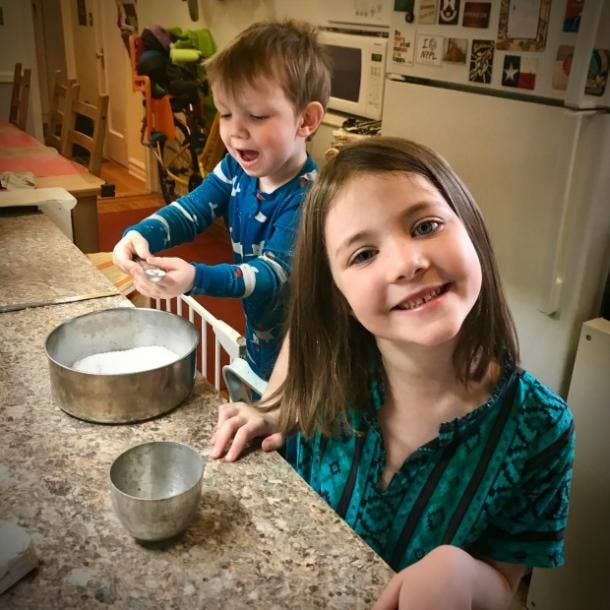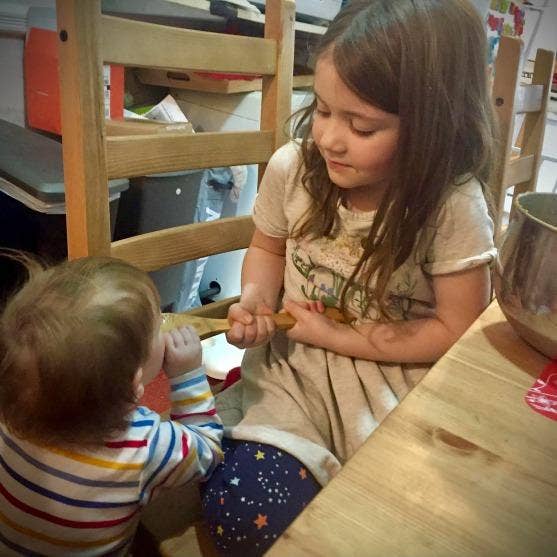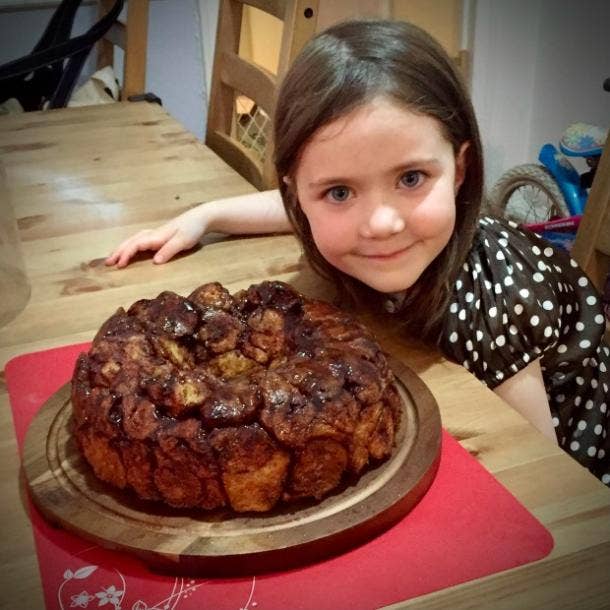We are side-by-side at the dining room table, our hands coated in sticky strands of dough. The bundt pan between us is half-filled with the tiny sugar-wrapped balls we have been shaping as part of our Winter Solstice tradition. Strapped in his high chair, my two-year-old gleefully dips his hands into his own assemblage of sugar, cinnamon, and melted butter, and licks them clean. My daughter rolls her eyes, but as she reaches for another clump of dough, she quips, “I wish it was morning so we could eat already!” It is late afternoon on Winter Solstice, our kitchen burnished by the last few hours of autumnal light, and we are circled around the table to mark the changing of the season. RELATED: Woman Leaves Fake Pregnancy Test In Her Bedroom To Catch ‘Snooping’ Mother-In-Law
Earlier in the day, we heated milk and butter and mixed them with sugar and yeast, watching the liquid thicken and bubble as I explained how billions of invisible microorganisms were gobbling up the dissolving sugar and converting it to a gas that would later make the bread rise. We poured snow-white flour into the mixer and slowly added what my son dubbed “the bubble beasts”, marveling as the bread hook spun the flour and milk together like golden threads around an enchanted spindle. Then we tugged free the sticky skein, kneaded it into a taut ball, and placed it in the warmed oven where hidden from watchful eyes, it would slowly double in size. When my daughter was born, I worried about holidays. As a queer white woman, I was acutely aware of how frequently marginalized identities are appropriated by the mainstream, and ever wary of perpetuating that cycle myself. I wanted to be intentional about which traditions we would honor — and why. RELATED: Woman Confronts Husband Of 25 Years After Catching Him In Home Of His Secret Second Family “We all deserve holidays, celebrations, and traditions,” Sasha Sagan writes in her part memoir, a part guidebook about ritual, “For Small Creatures Such as We”. “We all need to mark time… I do not believe that my lack of faith makes me immune to the desire to be part of the rhythm of life on this planet.” Could I, like Sagan, locate echoes in the stories of my ancestors and re-purpose them into something new? Our new family traditions celebrating Winter Solstice are just that. We join together on the longest night of the year to wait for the sun’s return and to celebrate our capacity for resilience through all the metaphorical periods of darkness in our lives. As the last streaks of a light dip below the windowpane, I remove the dough from the oven, and my children, with many zany sound effects, punch it down. We take turns cutting squares from the flattened sheet, twirling them between our palms into a hundred miniature globes. Each ball is wrapped around a single wish, spoken aloud in turn, then dipped in butter, sugar, and cinnamon, before it is at last tossed into the pan. Like any good bit of magic, it will transform three times before the night is done.
We pour the excess butter across the dough in glistening streaks, sprinkle it with the sparse remnants of sweetened spice, and place the loosely wrapped pan back into the oven to proof, or rise a second time. I wrest the empty dishes from my impatient toddler while my daughter wipes his hands and face, and then bundle the three of us against the night. We load candles and flashlights into the stroller, tucked beside the acorn caps and pinecones the children have been collecting all fall, and head toward the last place in Manhattan where there is still old-growth forest. “The wind is eating me!” my son howls. “It’s ‘biting’, not ‘eating’,” my daughter corrects him. As I hand him a Thermos of hot cocoa and tuck a blanket around his legs, I think of the old midwinter legends, so many of which are based around the bitter cold and the darkness of winter, or like fairy tales from so many cultures, cautioning children to obey their parents. I think of the Icelandic giantess Grýla and her 13 sons, the Jólasveinar, tormenting villagers and dragging misbehaving children back to their cave to be devoured. I think of Frau Prechta, descending from the Alps to slit people’s bellies and stuff them full of stones and straw; of Krampus, the demonic satyr who beats children with bundles of birch sticks and drowns them in his giant sack. The fear of consumption by the raw and bitter night undergirds so many of midwinter’s oldest rites. RELATED: Man’s Mom & Sisters Wore White To His Wedding As The ‘Ultimate Test’ For His Wife — So He Kicked Them Out When we reach the heart of the tallest strand of trees, we take out our candles and search for “fairy doors”, those hidden knots and hollow spaces that open into other realms when the moonlight lands just so. We scatter pomegranate arils and sunflower seeds at the base of an ancient red oak, and I tell the story my great-great-grandmothers might have told their children, ten generations ago when this forest itself was young, of the great battle between the Holly King and the Oak King for control over the year. We return home to find that, in our absence, the dough has risen to the top of the pan. Each chestnut-sized wish has expanded to the breadth of a plum, to the sheer delight of my children, who argue about whether it is the fairies or the yeast which are responsible for this change. Eventually, they conclude it must be both.
With the wisdom of childhood, they implicitly grasp that chemistry and magic, like the two faces of the god whose dueling personas mark the cycling of the seasons, are just different names for the same thing: the extraordinary wonder to be found in the countless metamorphoses that animate the world. This is the beauty of our family traditions in honor of Winter Solstice. They highlight the magic and wonder to be found in nature and commemorate the beauty to be found in the changing cycles of life. We turn up the oven and place the half-made bread inside. While we wait for the last stage of transformation to complete, we light candles in a hollowed birch log and curl up together beside the tree to read Susan Cooper’s “The Shortest Day”, our favorite yuletide poem: “So the shortest day came // and the year died // And everywhere down the centuries / of the snow-white world / Came people singing, dancing / to drive the dark away…” We have created our own rituals, marked by recipes that we return to each year, familiar recitations that soon my daughter will be old enough to read aloud herself. As we begin the story of Hades and Persephone, the sweet scent of bread envelops the room, and for a moment I glimpse time unfolding like the ripples of a skipping stone across a still pond. One day (I hope) my children will take up the mantle of these traditions and expand them further, new stories overlaying the old and spiraling outward in an evolving chain. I am reminded of the line by Mary Oliver: “All things are meltable and replaceable. Not at this moment, but soon enough…” And soon enough, indeed, the timer will alert us that the third and final transformation is complete. The bread will be taken out to cool, the candles burned down, and the children snuggled into bed. In the morning we will wake up and invert the pan, fill the center of the wheel with quartered pomegranates to remind us of the promise of spring. We will take turns glazing it, the layers of cream cheese like so many dustings of the new-fallen snow, and together we will gather at the table the way people have done from our earliest days of sentience, to greet the winter and welcome back the light. RELATED: Woman Disturbed After Finding Folder Husband Compiled About Her Background Before They Got Married Jenna Devany Waters is a queer writer, teacher, and single mother. Her work has been featured in Orion, Alaska Quarterly Review, The Citron Review, JMWW, and MUTHA Magazine. All photos are courtesy of and owned by the author.


